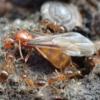So, I recently became aware of the fact that in Rhode island (a hour or twoa way from where I am currently located), exists colonies of trachymyrmex septentrionalis. As you can imagine, I want to look further into this later this spring or summer and possibly dig up a colony. I have seen them cultured in laboratories in Uconn with incredible ease. What would you recommend in terms of "food" for the fungus (I have heard of people using yeast, caterpillar and rabbit droppings and petals, but I would like to see if there are any other options.)? Do they respond to captivity well upon being moved from the wild in the form of mature colonies? Any suggestions for setups (I have a few idea, but would like to see what you guys think about this.)? Any other information / tips I should now? etc.
Edited by ctantkeeper, March 25 2017 - 3:25 PM.
















